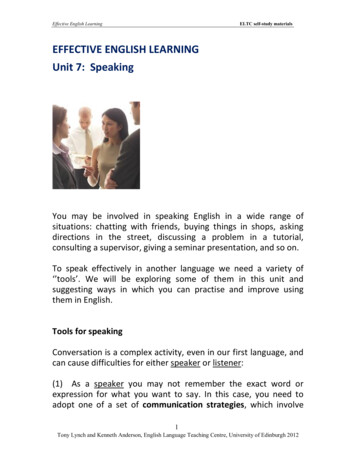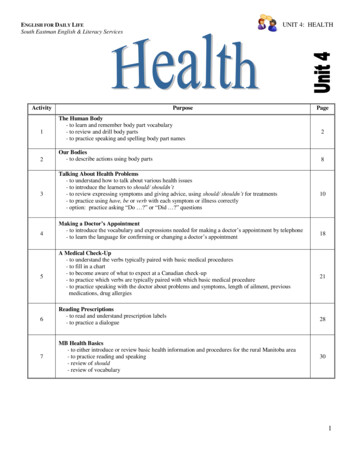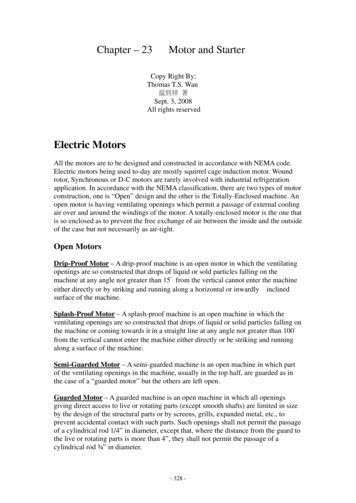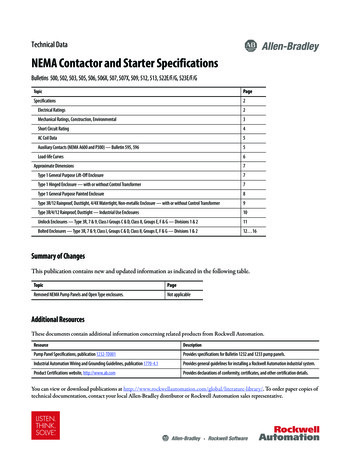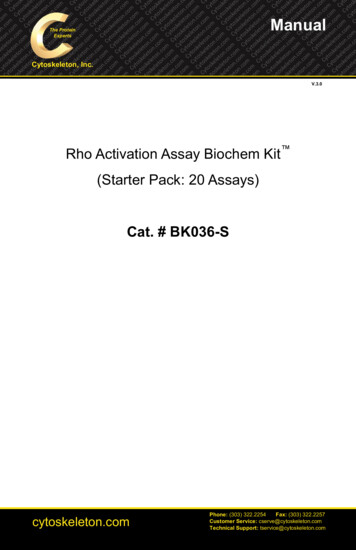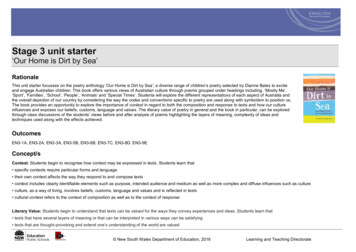
Transcription
Stage 3 unit starter‘Our Home is Dirt by Sea’RationaleThis unit starter focusses on the poetry anthology ‘Our Home is Dirt by Sea’; a diverse range of children’s poetry selected by Dianne Bates to exciteand engage Australian children. This book offers various views of Australian culture through poems grouped under headings including, ‘Mostly Me’,‘Sport’, ‘Families’, ‘School’, ‘People’, ‘Animals’ and ‘Special Times’. Students will explore the different representations of each aspect of Australia andthe overall depiction of our country by considering the way the codes and conventions specific to poetry are used along with symbolism to position us.The book provides an opportunity to explore the importance of context in regard to both the composition and response to texts and how our cultureinfluences and exposes our beliefs, customs, language and values. The literary value of poetry in general and the book in particular, can be exploredthrough class discussions of the students’ views before and after analysis of poems highlighting the layers of meaning, complexity of ideas andtechniques used along with the effects achieved.OutcomesEN3-1A, EN3-2A, EN3-3A, EN3-5B, EN3-6B, EN3-7C, EN3-8D, EN3-9EConcept/sContext: Students begin to recognise how context may be expressed in texts. Students learn that specific contexts require particular forms and language their own context affects the way they respond to and compose texts context includes clearly identifiable elements such as purpose, intended audience and medium as well as more complex and diffuse influences such as culture culture, as a way of living, involves beliefs, customs, language and values and is reflected in texts cultural context refers to the context of composition as well as to the context of responseLiterary Value: Students begin to understand that texts can be valued for the ways they convey experiences and ideas. Students learn that texts that have several layers of meaning or that can be interpreted in various ways can be satisfying texts that are thought-provoking and extend one’s understanding of the world are valued New South Wales Department of Education, 2016Learning and Teaching Directorate
Representation: Students understand that representations position audiences to adopt a particular response. They learn that information and ideas may be represented symbolically representation in each mode operates according to its own codes and conventions representations may be adapted for different audiences representations influence responseTextsOur Home is Dirt by Sea: Australian poems for Australian Kids, selected by Dianne Bates, Walker Books, Australia, 2016At the Beach by Roland Harvey, Allen and Unwin, Australia, 2006Focus questions for responding and composing How does context effect both composition of and responses to texts?How are culture and context connected?Why is poetry valued in our society?How do these poems create representations of Australia and how do they influence our responses?Prior knowledge Poetry forms and featuresAssessmentStudents choose their favourite poem from their own work and refine it, with the support of peers, and edit it prior to submitting it for publishing in the class anthology. New South Wales Department of Education, 2016Learning and Teaching Directorate
ProcessesUnderstandingIn responding andcomposing studentsdraw from a range ofstrategies to interpretinformation and ideas intexts. They recogniseand explain howlanguage and structurescommunicate ideas. Engage personallyStudents explore moreformal and informalways to express theirpersonal responses,showing an awarenessof the impact of theirown and others’language choices.ConnectingThrough respondingand composing studentsclosely compareaspects of language inand between texts toexplore how texts maybe connected.Evidence oflearningLesson Sequence Explain to students that the context of a text can be expressed as the purpose, intended audienceand the medium of a text. Ask the students to answer the questions: Who is the intended audience?What is the medium of the text? and What is the purpose of the text? They will answer the first twoeasily by looking at the title of the book and glancing through the pages of the book, but may not beas sure of the purpose. Read the Forward to the students and identify the different purposesprovided including wanting to honour specific Australian poets, appeal to children and make themhave an ‘Ah’ moment, maybe learn them off by heart or maybe want to write your own. This can alsobe linked to the perceived literary value of this text. Ask students why the composer values poetry asa form and what does she hope to achieve in putting this anthology together. (Context, LiteraryValue)Explain to students we can also consider the cultural context of the book revealing a way of living,involving beliefs, customs, language and values. Choose a range of poems from the anthology toshare with students and try to identify the cultural context that is presented. (Context)DiscussionImaginativedrawingStudents choose one of the sections of the book to explore more closely. Read 3-4 poems from thatsection and fill in a table explaining what they like about each poem, dislike about each and the waytheir own experiences influence their thoughts about the representations of Australia presented.Provide students with examples of ways they could express their opinions, if necessary. Forexample, The simile ‘ ’ was great as it was a clever connection. The unique language like ‘ ’ wasinteresting. The pun ‘ ’ made me laugh. The humour The tone Or Confusing language like ‘ ’made it hard to understand rather than just writing it’s boring, dumb etc. (Representation, Context,Literary Value)Students then choose their favourite poem to adapt to represent their own view of an aspect ofAustralia, i.e. a student likes the Horse Riding poem but adapts the form to write aboutskateboarding. Share their poem with a group of peers and discuss ways it reflects their view of theworld and what they were trying to tell their audience. (Representation, Context)TableAdapted poem anddiscussionCompare and contrast the poems in the ‘Families’ section to identify a similar feature/ technique thenhow they use this to represent differences in families and then how this leads to a shared view offamilies in Australian culture. For example,They are all written in first person from a child’s point of view one looks at unique parents, one isfighting and name calling with their sister, one is in trouble shopping etc. but all create a view oflove and acceptance in families. Discuss with students the ways these representations influence ourthinking about families and what they mean to Australians. Ask students to write a poem about theirfamily. (Representation)Compare andcontrast sentencesCharacteristicschart New South Wales Department of Education, 2016Learning and Teaching Directorate
Processes Compare the picture book ‘At the Beach’ by Roland Harvey (or another type of text that representsthe beach) to the poem A Beach of My Own. Complete a characteristics chart considering theelements of context they can find (beliefs, customs, language and values) as well as the links topurpose, audience and medium. Discuss the range of language features used in the poem, includingconnectives such as ‘So too’ the use of ellipsis and the ‘Please note:’ to close the poem, the use ofnumbered short statements of rules etc. Ask students to copy the form and write a poem titled, ‘ASchool of My Own’ (Context) Explore with students a range of poems that use symbolism. Identify the information and ideas thatare linked to the symbolism and decide whether understanding the symbolism is dependent on theirAustralian cultural context. For example, The Tree, Christmas Visitor, Monday Blues, Camping, relyon understanding the symbolism of elements of Australian history, the outback, a bad day, andnature. After discussing these, students write statements related to the effectiveness of symbolismas a technique. Use a scaffold if necessary to support student writing. For example, ‘Thepoem uses the symbolism of to represent as seen in the line This use of symbolism iseffective/ not effective because (Representation, Context)Students consider the literary value of a text linked to our definition for this stage. Provide them witha checklist and then assign them to analyse some of the poems not studied by the class as yet.Students evaluate the poem against the checklist and then report back to the class. Discuss thefindings and decide on how they would describe the literary value of this text as a whole. (Literaryvalue)Checklist of indicators of literary valueConveys experiences and ideas in interesting waysThere are several levels of meaningIt can be interpreted in various waysIt is thought provokingIt extends our understanding of the worldEngaging criticallyThrough respondingand composing studentsrecognise that texts caninfluence and positionresponders. Theyanalyse and evaluatedifferent ideas andvalues in texts.Evidence oflearningLesson Sequence New South Wales Department of Education, 2016DiscussionEvaluativestatementsChecklist andevaluationLearning and Teaching Directorate
ExperimentingStudents experimentwith text structures,language features andtextual concepts toadapt texts and ideasfor different purposesand in a range of modesand media. ReflectingStudents identify, useand discuss textprocessing strategiesand assess thedevelopment of theirown skills againstagreed criteria. Theyconsider strategies forcollaborating with theirpeers and reflect ontheir learningachievements. Tell students to read the poem Fishermen silently in their heads. Then ask if they can understandthe words and identify what the author has done. The poem cleverly uses slang and merges wordstogether with incorrect spelling to create dialogue between two people. For example, the opening 4lines are ‘Hiyamayt. / Lobuddy. / Binearlong? / Cuplours.’ Then read it out aloud in pairs. Discuss theeffect it creates and the students’ views of the technique. Also discuss the literary value of the poemin relation to this technique and then considering the inventiveness and the extra layers of meaning itpresents. Ask students to work in pairs to write a conversation representing a shared schoolexperience. Then students present their poems to the class. (Representation, Literary value)Read the poem Hills with students and identify the intended audience, medium and the purposethrough an analysis of the techniques. The poem conveys the joy and exhilaration of running downthe hill out of control, through the language used, the punctuation, the rhythm and rhyme as well asthe sensory detail. Have students now consider what other purposes a poem about hills could serve,e.g. to warn of danger of running down it, to explore its flora and fauna, to describe a great view orthe feeling of being alone or brave at reaching the summit etc. Ask students to brainstorm ways theycould convey this through their writing and then write a new hill poem with their new chosenpurpose. (Context)Ask students to reflect on their view of the value of poetry before and after this unit of work. Explainwhy they think they have changed their opinion or what activities have confirmed their original views.As part of the Assessment task, ask students to reflect on their work in this unit by answering thefollowing questions:o Which poem writing activity did you like the best in the unit?o What was good about this activity?o What poem do you think is your best? Why do you think it is?o What does this tell you about the way you work best?Students choose their favourite poem, which they will be working on for the assessment task and willbe added to the class anthology. Students need to think of 3 questions they could ask peers to gainfeedback on how well their poem achieves its purpose. For example, ‘Did you understand thesymbolism I used?’ ‘Could you understand the slang?’ ‘Did the simile make a strong picture in yourhead?’ ‘Could you recognise this Australian setting?’ etc. Students then work in small groups andshare their favourite poem and take notes on the feedback received. Students then use this to helpthem decide on any changes to be made to their poem before they edit and publish for submission.The reflection questions and peer feedback and answers worksheet should be submitted with thefinal poem.Writing indialect/dialoguestyleCreating Hills poemin new contextReflectiveparagraphThe intention of this unit starter is to illustrate teaching and learning activities for each of the processes.The processes may be taught in any order to cater for the needs of all learners and further differentiation can be included in your full version of the unit. New South Wales Department of Education, 2016Learning and Teaching Directorate
could convey this through their writing and then write a new hill poem with their new chosen purpose. (Context) Writing in dialect/dialogue style : Creating Hills poem in new context . Reflecting . Students identify, use and discuss text processing strategies and assess the development of their own skills against agreed criteria. They consider strategies for collaborating with their peers and .





